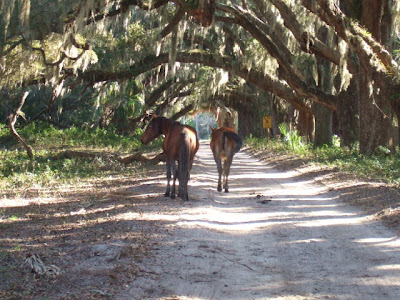The Wild Horses of Cumberland Island



I just got back from our annual trip to Cumberland Island Georgia, and ohhhh did I need it. You can feel your blood pressure drop the moment you get off the boat. We've been very fortunate to rent Nancy's Fancy for a week each year since we were married over there. It is a house on pilings behind the dunes overlooking the beach......a deserted beach. The kids can run wild and like it was when I was a kid, you just have to be back before dark. One of the cool things about Cumberland Island are the wild horses....I know, I see horses everyday so whats the big deal. I don't usually see herds of them walking down the beach. There are those that want the horses removed and have their own agenda but for everyone else it really adds to the whole Cumberland experience.The National Park Service does a good job of keeping the environmental extremists at bay and follows the Wild Free-Roaming Horses and Burros Act of 1971 to protect them."The Wild Free Roaming Horses and Burros Act was an act passed on December 15, 1971. The act was passed because of public outcry against the commercial exploitation and decreasing numbers of the wild horse herds on federal lands. The passage of the act specified that the wild horses and burros could only be managed in the areas that they inhabited at the time of the passage. The act was originally directed at the U.S Forest Service and Bureau of Land Management, but the National Park Service has also adopted its guidelines. The objective of the regulations within the act are "management of wild horses and burros as an integral part of the natural system of the public lands under the principle of multiple use; protection of wild horses and burros from unauthorized capture, branding, harassment, or death; and humane care and treatment of wild horses and burros "(BLM 2002). Whatever view is held, with the passage of the Act, these horses are being protected as part of the natural system. Therefore, they are managed as an integral part of the systems in which they inhabit." From the scientific aspect there seems to be adequate food available and disease and parasitism has not reduced the numbers. The overall health seem OK as the body weight and condition scores are good. Most of the adult females appear pregnant ( or have a serious hay belly) and fair to good hair coats. As we went over most of the Island you can see several herds with most of them situated on the Southern half. I think it is related to the Islands history and the fact that most of the development and Plantation farming was on the Southern end and therefore more land was cleared. While there is minimal development now , there is more open grazing area there and the grasses help support the numbers. At low tide you can see a large number of horses move through the marsh areas and graze on many of the marsh grasses that are all over the place. Having walked...or tried to walk through the marsh mud, I can't see how they don't become trapped , but I never find evidence of bones or a carcass. I did see a small whale carcass on the beach though. All in all it was another fantastic time but sadly it may be coming to an end. The Government takes over most of the privately
 owned homes in 2010 through eminent domain and deals made with the owners. My in-laws had a house they built in the 70's that was taken via eminent domain and it is a wound that for them still hasn't healed. Perhaps with time . There is a chance that the Government will lease these houses back to the owners and places to stay will still be there, as it stands you either camp or stay at the Greyfield Inn (a 5 star Inn in the Wilderness). We may get lucky and get to go back again next year.
owned homes in 2010 through eminent domain and deals made with the owners. My in-laws had a house they built in the 70's that was taken via eminent domain and it is a wound that for them still hasn't healed. Perhaps with time . There is a chance that the Government will lease these houses back to the owners and places to stay will still be there, as it stands you either camp or stay at the Greyfield Inn (a 5 star Inn in the Wilderness). We may get lucky and get to go back again next year.

Comments
mathesonlucie@aol.com